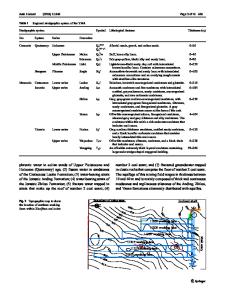Petroleum geological characteristics and hydrocarbon accumulation patterns in the Melut Basin, South Sudan
- PDF / 1,679,324 Bytes
- 16 Pages / 595.276 x 790.866 pts Page_size
- 102 Downloads / 555 Views
ORIGINAL PAPER
Petroleum geological characteristics and hydrocarbon accumulation patterns in the Melut Basin, South Sudan Wei Zhao 1 & Zhongsheng Shi 1,2 & Shuangwen Li 1 & Bintao Chen 1 & Xue Luo 1 & Wenzhu Pang 3 Received: 26 March 2020 / Accepted: 19 October 2020 # Saudi Society for Geosciences 2020
Abstract The Melut Basin is a passive rift basin controlled by the Central African Shear Zone (CASZ), which contains numerous oil-rich rift sub-basins. After 20 years of large-scale hydrocarbon exploration, it has become increasingly difficult to find new discoveries, and it is necessary to deepen the understanding of petroleum geology, identifying new hydrocarbon accumulation patterns and establishing typical oil reservoir models to promote the future exploration in the Melut Basin. In the north Melut Basin, the farsource migration and accumulation pattern has been identified for the Paleogene main producing layer, which provided more than 95% oil reserves in the past years. For the Paleogene far-source accumulation pattern, the capability of hydrocarbon charge from the Al Renk source rocks and the development of oil-source faults connecting Al Renk source rocks and Paleogene reservoir rocks determine if the Paleogene traps can accumulate hydrocarbon. Using the model of the far-source accumulation pattern, numerous oil reservoirs have been discovered in the north Melut Basin, including the world-class Palogue oilfield. In addition to the Paleogene far-source accumulation pattern, three new near-source accumulation patterns have been identified in the Cretaceous, including the accumulation pattern of Galhak Formation, the accumulation pattern of Al Gayger Formation, and the accumulation patter of Al Renk Formation. Meanwhile, the typical oil reservoir models have been established for each nearsource accumulation pattern. These new accumulation patterns and corresponding typical oil reservoir models should promote the exploration of the Cretaceous sequence in the Melut Basin. Compared to the north Melut Basin, the sub-basins in the south Melut Basin have smaller areas and coarser siliciclastic sediment infillings, which make the quality of Adar caprocks worse. Consequently, the Paleogene reservoir (Yabus and Samma Formations)-caprock (Adar Formation) pair is not an effective petroleum system combination in the south Melut Basin, and the near-source Cretaceous has better exploration potential. Affected by the movement of the East African Rift System in Paleogene, the Melut Basin widely developed inversion structures with numerous uplifts and faulted blocks, which provide good trap conditions for hydrocarbon accumulation. Three types of inversion structures have been identified, including the inner-basin inversion structures, the basin-margin inversion structures, and the inversion structures between sub-basins. The inner-basin inversion structures and the inversion structures between subbasins have better oil-source and trap conditions and are important oil-bearing structures. However, the basin-margin inversion stru
Data Loading...











